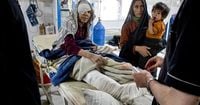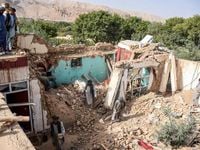In the pre-dawn hours of Monday, November 4, 2025, northern Afghanistan was jolted awake by a powerful 6.3 magnitude earthquake, leaving a trail of devastation across several provinces. The quake, which struck at exactly 12:59 a.m. local time, had its epicenter 22 kilometers west-southwest of the town of Khulm, at a depth of 28 kilometers, according to the United States Geological Survey. The impact was felt most acutely in the provinces of Balkh and Samangan, but tremors and damage rippled as far as Baghlan and Badakhshan, underscoring the region’s vulnerability to natural disasters.
At least 20 people lost their lives, and more than 640 others were injured, with 25 reported in critical condition, as confirmed by Afghanistan’s National Disaster Management Authority. The figures, officials cautioned, could still rise as rescue efforts continued and more remote areas became accessible. Hospitals in Balkh and Samangan provinces bore the brunt of the emergency response, receiving over 500 of the injured and the dead in the immediate aftermath, as reported by Sharafat Zaman, spokesperson for the Ministry of Public Health. "Rescuers were on the scene and the figures were changing," Zaman told reporters, highlighting the chaotic and evolving nature of the disaster response.
Scenes of heartbreak and resilience played out across the region. In the village of Muhammad Rahim Sarkhel, Ghulam Mahmoodi and his family were among those whose lives were upended in an instant. Mahmoodi, jolted from sleep by the tremor, managed to rush his wife and two daughters to safety before returning to rescue his mother. Tragically, his youngest daughter, Zainab, just 10 years old, was buried under debris after a hillside collapsed onto their home. Hours later, she was declared dead. "Now I have nothing — no food, no home and no hope for surviving," Mahmoodi told The New York Times, his words echoing the despair of many Afghans caught in the quake’s aftermath.
The destruction extended far beyond individual households. In Badakhshan’s Shahr-e-Bozorg district, 800 houses in a single village were either damaged or destroyed, according to Ihsanullah Kamgar, spokesperson for the provincial police. Due to limited internet access in the remote area, casualty figures remained uncertain, but the scale of the devastation was clear. Most of the injured, said Yousaf Hammad of the National Disaster Management Authority, suffered minor wounds and were discharged after treatment, yet for many, the emotional and economic scars would linger far longer.
Rescue and emergency aid teams, including those from the Afghan Ministry of Defense, quickly mobilized to the hardest-hit areas, particularly Balkh and Samangan. Their efforts included transporting the injured to hospitals and providing assistance to families whose homes and livelihoods had been shattered. A rockslide triggered by the quake briefly blocked the main mountain highway connecting Kabul to Mazar-e-Sharif, complicating rescue operations. The road was later cleared, allowing ambulances and aid to reach those stranded, as reported by both China Daily and Al Jazeera.
Among the most visible casualties of the quake was the historic Blue Mosque in Mazar-e-Sharif, a 15th-century architectural marvel and one of Afghanistan’s most revered religious sites. The mosque’s iconic turquoise tiles fell from its minarets, and parts of its walls and historical inscriptions were damaged. While the structure remained standing, access was barred to visitors, worshipers, and journalists. The Blue Mosque, believed by many to be the burial site of Ali, the son-in-law of the Prophet Muhammad, is a focal point for Islamic festivals and a symbol of Afghan heritage. Its damage has struck a chord with locals and the wider Afghan diaspora, amplifying the sense of loss.
The earthquake’s timing could hardly have been worse. It struck just weeks after another deadly quake in eastern Afghanistan, which killed at least 2,200 people in August. The country, already reeling from a series of natural disasters, is grappling with a cascade of humanitarian crises: sharp cuts in foreign aid, the return of more than two million Afghans from neighboring countries amid rising xenophobia, and skyrocketing housing prices in urban centers like Kabul. Over half of Afghanistan’s 42 million people are estimated to be in need of humanitarian assistance, a figure likely to rise as winter approaches and displaced families struggle to find shelter and food.
International response was swift. Hadja Lahbib, the European Union Commissioner for Equality, Preparedness and Crisis Management, expressed solidarity with the Afghan people, calling the news “heartbreaking.” She assured that EU humanitarian staff and partners were on the ground, assessing needs and preparing to provide support. The United Nations also confirmed its teams were delivering urgent aid and evaluating the most pressing needs in affected communities.
For many survivors, the road ahead looks daunting. Abdul Aziz Kamawal, 18, suffered a broken femur in the quake and was told he would need the equivalent of $600 for surgery—four months’ salary at his job in an iron factory. “I can’t even support my family, so how can I pay the price of surgery?” Kamawal lamented from his hospital bed, as reported by The New York Times. Stories like his are all too common in a country where the health care system has been weakened by years of conflict and aid shortfalls.
Afghanistan sits atop the collision zone of the Eurasian and Indian tectonic plates, making it highly susceptible to earthquakes. The August quake alone caused an estimated $183 million in damage, according to the World Bank—about one percent of the country’s gross domestic product. These recurring disasters have left villages flattened and families living in tents, their futures uncertain as the government and international agencies struggle to keep up with the mounting needs.
Despite the scale of the tragedy, moments of resilience and unity shone through. Local rescue teams, supported by government agencies and international organizations, worked tirelessly to clear rubble, transport the wounded, and distribute food and supplies. Social media was flooded with images of destruction but also with calls for solidarity and support, as Afghans and the global community rallied in the face of hardship.
As night fell on Monday, uncertainty lingered. Officials warned that casualty figures could yet rise as rescuers reached isolated villages and more accurate assessments became possible. Yet amid the grief, there was also a sense of determination—a recognition that, even in the face of repeated disasters, the Afghan spirit endures.

